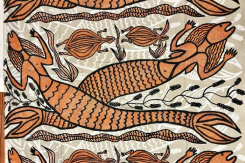History of West Phoenicia
This article is incomplete because it is pending further input from participants, or it is a work-in-progress by one author. Please comment on this article's talk page to share your input, comments and questions. Note: To contribute to this article, you may need to seek help from the author(s) of this page. |
Prehistoric History
The Neolithic Era
Archaeologists have theorised through multiple archaeological site excavations, human habitation of the area now known as West Phoenicia sprung up 7000 to 8000 years ago during the Neolithic period.
Five distinct ethnic groups migrated into the region from at least 8000 years ago.
The distinct ethnic groups left their mark through cities, paintings, artifacts and written and oral histories.
The Mermania
Archeological evidence discovered across a number of sites has the Mermania people migrating and settling across coastal locations of the northern and eastern coasts of modern-day West Phoenicia.
Surviving oral history transcripts compiled between 1775-1970 by Dr Richard Marcos; head of the Anthropology Department at the University of Jacksonia, strongly show Mermania settlements consisted of a matriarchal social system. The settlements werr separated into family bands, led by a female elder.
The Mermania were renowned for their skilled boat making. The skill enabled the clans to focus on fishing.
The clans consumed freshwater and saltwater fish, crab and oysters. The Mermania foraged for seaweed, fruits, nuts and roots to supplement their diets.
Jewellery was produced using pearls and shells. Jewellery was adorned by all members of the tribes and held no monetary or social status.
Due to the close proximity to water, Mermania tribe members were excellent swimmers. Oral history tells that during the Summer months, clans would come together in times of fellowship; at these events, friendly swimming competitions were held.
West Phoenician philosophers and poets have written works about the Mermania tribe descending from Mermaids and Mermen who left the oceans for land when they evolved.
The Deserti
The Deserti People, as they are referred to by historians, due to their proximity to the drier harsher territories in the central and southern parts of the region. The Desert People didn't have a singular name, rather each band was identified by their location. The more well-known tribes were "The People of the Mud River" and Desert Fox Clan.
The Desert People were renowned as fierce fighters; especially in hand to hand combat. Land border disputes and access to freshwater supplies placed tribes at odds with each other.
It was common for members of individual tribes to be aggressive towards members of their own tribes when it came to disputes over resources. Disputes were settled in hand to hand combat with the victor inflicting an injury on their opposition.
These hunter and gatherer seasonal nomads would migrate towards warmer locations during the winter months.
The Desert People resided in massive tent cities made from animal hides and wood that protected them from the elements. Desert People women were responsible for putting up and taking down the tents.
Hunting was performed by both genders. Their main sources of diet were animals like rabbits, lizards, snakes and birds. Roots, nuts and other sources of food were obtained through foraging. Foraging was handled by the children.
The tribes were split into family bands with each band controlled by a chieftain who obtained the role from a fight to the death with the previous chieftain.
Hapicuhtli, the double-faceddeity worshipped as their Supreme deity. Hapicuhtli represented Fire and Water. They were Animalistic in general.
Each year tribes held an annual sacrifice of one boy and one girl child to appease their god. One offering was burnt alive to appease the fire. The other drowned to appease the water.



